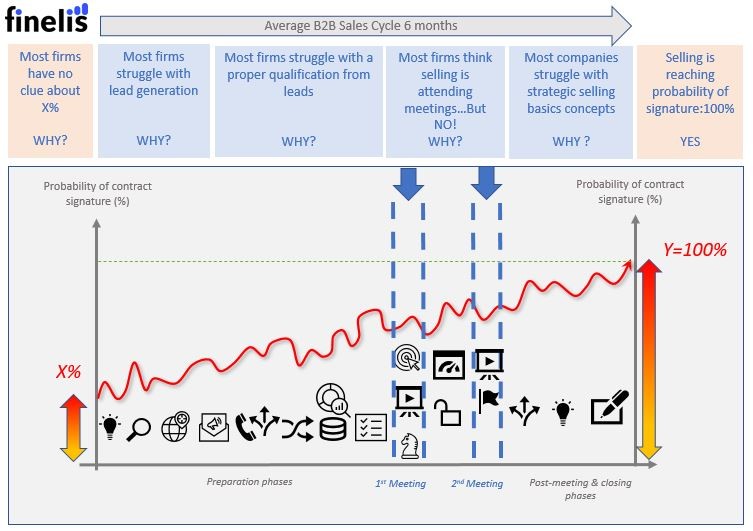You may be wondering what common ground there is between the current health crisis of 2020 and Strategic selling? Simply the awareness of change, which is a constant in the new paradigm.
In “Strategic selling,” we learn that change is a constant that must be continually evaluated and reassessed over time. Keeping an outdated representation of Change in your equations leads directly to failure.
To mention a brief example, a mere reorganization or the resignation of a “decision-maker” can lead to the termination of a contract if it has not been possible to anticipate or quickly react to such a change and “stay on track.”
📌 Changes are rarely considered. Since March 2009, when I created Finelis to assist companies with strategic and operational international sales issues, I have found that changes of all kinds (organizational, technological, economic, legal, social, psychological or simply “commercial”) are not taken into account when analyzing business indicators and other “KPIs.”
📌 Sales figures VS Operational reality. Some will say that sales analysis is “quantitative” and “qualitative,” operational reality, and its understanding might be different. When sales are up to standard, analysis and strategy are usually underestimated, and when sales do not meet expectations, the tendency is to overestimate minor elements to explain low profitability. In most cases then, there is little or no strategy, and the essential criteria that contributed to success or failure are not considered. Why? Because many managers, no matter how good they are, would think that if you have good sales, it is because the products are good, and the salespeople are (fairly) good. If, on the contrary, sales go badly, it is because products are not good enough and/or salespeople are not competent. This binary judgment shows that changes are usually not considered (and if so, it may be too late).
📌 Being attentive to one’s customers (and therefore to one’s sales representatives) without any fear of being “100% collaborative”. Many companies in a globalized economy know, before they succeed, that entering the market should not be taken lightly and that they will have to be resilient (therefore responsive to many changes). Above all, they must be aware of their customers, their sales representatives, and all the support staff in the sales team (i.e. everyone with no exception).
📌 Deploying a sales strategy appropriate to the supply and its market is a rigorous task that requires local support and assistance with essential sales functions. The old-fashioned individualistic superstar salesman, who saves the company on his own, is a thing of the past. He has never existed; he has only used his skills and benefited from economic conditions that do not exist today and even less tomorrow (i.e. little to no transparency, no CRM, no social networks, no collaborative culture).
📌 Agility required (at last). Oddly enough, before this dramatic health crisis, many countries talked a lot about social issues, often requiring social crises like the “yellow vest” for many companies to realize that they could continue to work remotely (teleworking). This trend has existed since the Internet boom in France in 2001, the year I started working in the banking sector! This late realization has allowed many companies, in recent years, to evaluate coworking offices and cost-effective solutions to reduce unnecessary expenses and “dive,” sometimes utterly unprepared, into the world of flexibility.
This health crisis has forced most people to remain confined to their homes and work from there. However, although everyone is aware that after the crisis, almost everything will have to be rebuilt, many agree that the existing traditional models are already dead. Agility has been talked about for many years; it is being imposed on us today!
Today, businesses must still exist and/or survive, and salespeople must continue to sell or find ways to “sell even better” by spending less time meeting with their customers and remaining profitable working from home or (empty) offices.
Without this agility and sales intelligence (and sales outsourcing is not the only solution!), the entire HR market for contracting these so-called “commercial” profiles will be compromised after 2020 (not adapted to the culture of collaboration, individual performance indicators, and inadequate annual assessment frequencies, etc.).
📌 Empathetic and accessible leaders should prevail in the race for agility.
Nobody saw this crisis coming. Leaders haven’t always shown interest in collaborative work and their evolving ecosystem . Millennials, and those born after 1985 have contributed much to this positive movement. For experts with little or no interest in commercial expertise (even when working with a highly skilled professional) the crisis will only reinforce their willingness to work in closed silos. Their added value will be limited to their own silo, and they will not be able to play the “100% collaborative” role. For those who know that sales and marketing teams must move forward hand in hand and be agile, it’s not a big change. They are already used to working via video conferencing and across different time zones in brand new and often international startups – it is in their DNA. What will change is that the “old-fashioned salesmen and saleswomen” will have to take a much greater interest in the work of his/her support teams (Marketing, IT, etc.).
In contrast, marketing teams interested in sales and overall selling data will benefit from exciting opportunities to develop real skills in terms of sales strategy, whose concepts, of course, apply equally to marketing. I am referring to this “à la carte” sales and marketing mix (SaaS for “Sales as a Service”) in this BFM interview (December 2018).



- Knowing how to reasonably estimate and maximize the value of X before “running into execution” (X% probability of signature at the beginning of a sales cycle).
- Applying “Strategic Selling” concepts (BANT methodology, ICP, buying influences, Strengths/red flags, competition etc.) and Running sales execution accordingly and realistically
- Generating qualitative “leads” (MQL & SQL) that can be turned into real opportunities through a professional and rigorous qualification.
- Organizing & Managing meetings remotely (confinement mandatory) according to an optimal “timing” for your end client/partner.
- Improving qualification criteria much earlier in the sales process thanks to adequate tools, processes, and methods including CRM & marketing automation
- Building an agile salesforce (be it half a person in one city or a team of 10-20 people in 5-10 countries) that take care of the full picture: Sales, Marketing & data quality through CRM.
- Investing in Branding & social networks after reviewing all your communication channels (direct and indirect).

If this article is of interest, we will be very happy to exchange it or propose that we walk together on the road to our 1st success… and due to the health crisis, we are offering exceptionnal discounts from April 2020 to our new customers and partners!

